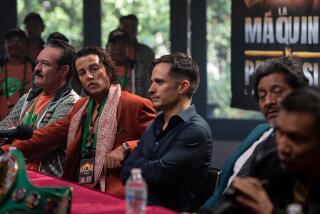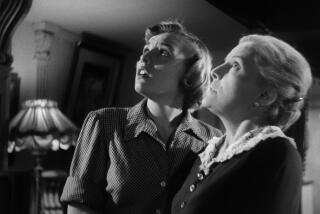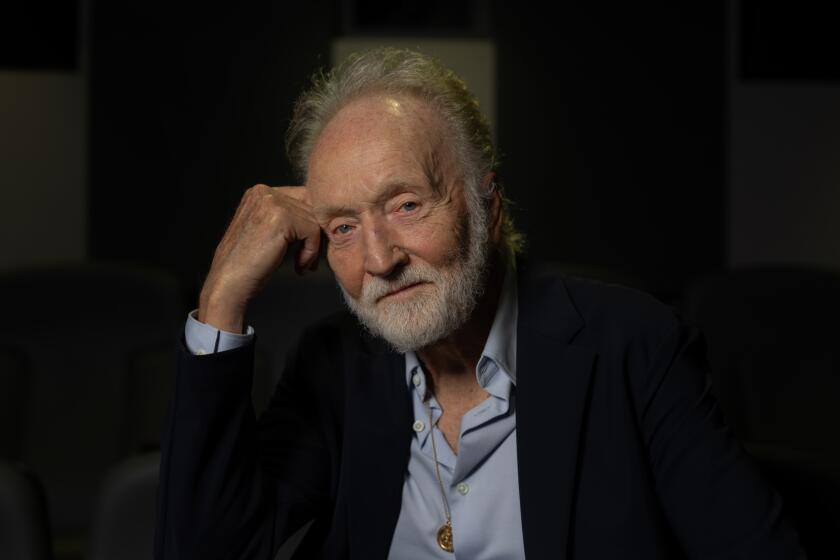The Missing ‘Dracula’ : The Revival Premiere of the More Erotic Spanish Version, Unseen Theatrically Since 1931, Screens Tonight at UCLA
It’s a Halloween tradition that all manner of strange and unusual sights reveal themselves on this dark night of nights, and the UCLA Film and Television Archive is honoring that spooky pattern by offering the revival premiere of the Spanish-language “Dracula,” a celebrated film unseen theatrically since its debut in 1931 and long thought to be at least partially lost.
The Spanish “Dracula” has earned legendary status for several reasons. It was made simultaneously with its more well-known English-language version, directed by Tod Browning and starring Bela Lugosi. Thus, writes David J. Skal in “Hollywood Gothic,” the best source for information on the Dracula phenomenon, it offers “one of the few examples in world cinema of a simultaneous, alternate rendition of a familiar classic, richly illustrating the interpretive possibilities of a single script.”
Better still, the Spanish “Dracula” has always had the reputation of being more erotic than its timid English version, and although there is nothing here that would make Madonna think twice, the sensuality quotient is a pleasant addition to the story.
And, frankly, the Spanish “Dracula” has been celebrated because it has been so difficult to see. The Library of Congress has a copy that has been shown at film festivals, but it is missing the crucial third reel. For years it was rumored that the Cuban Film Archives in Havana had a complete print, and it was to that institution that UCLA, at the request of Universal Studios, went for help in restoring the version that is being screened tonight at 7:30 at the university’s Melnitz Theater. Admission is free, and, although it is not as much of a problem as it may sound, the film is being shown without English subtitles.
The whole business of doing simultaneous foreign-language versions came up when the advent of sound threw the international film market into one of its periodic tizzies. Paul Kohner, then a Universal executive but later to become a powerful agent, suggested to studio head Carl Laemmle that doing films in two languages at once was a cost-effective way around the situation, and “Dracula” was one of the first test cases.
So, after Browning, Lugosi and the American crew left at 6 p.m, the Spanish-speaking cast, including Carlos Villarias as the no-account count and Lupita Tovar as Eva, the damsel in a whole lot of distress, took over the premises at 8, Villarias even going so far as to make use of Lugosi’s hairpiece. The original cast, Tovar told author Skal in a recent interview, were “very nice, but condescending. We were the children and they were the grown-ups, you see.”
Directing the children was George Melford, who did not speak any Spanish but had directed Valentino in “The Sheik,” a credit that apparently meant a lot more. He soon had the Spanish-language cast working at such a brisk clip that one of the differences in the two versions is that Melford’s team got to the Carfax Abbey set before Universal’s professional spiders were able to dress it with many of the cobwebs visible in the Lugosi film. The Spanish version was also more cost effective: It was shot in 22 nights and cost only $66,000 and change, while Tod Browning took seven weeks and spent nearly $442,000.
It’s because the Lugosi version is so familiar, however, that this one can be understood without fluency in Spanish. Phrases like “Soy Dracula” (“I am Dracula”) and “Sangre es la vida” (“Blood is life”) are more or less clear to non-Spanish-speaking audiences either from the context or from memory.
The Spanish “Dracula” certainly shares in the drawbacks of the original in being on the slow side and rather stage-bound, but it is noteworthy for its considerable (for its day) eroticism. The three vampettes who share Castle Dracula with the count are glimpsed only briefly, but they are considerably more animated than their English-speaking sisters, and when Eva falls under the count’s spell, it serves to make her much more vivacious and sexually alive. And Tovar wore such a collection of slinky negligees that when she showed the film to her grandson he told her, “ Now I know why Grandpapa married you!”
Although aficionados of the original version will be able to note many differences between the two, such as the greater range given to the mad, fly-obsessed Renfield (here played by Pablo Alvarez Rubio), there is one area where the Browning version remains superior, and that is in the name above the title. No one has ever spoken the part of the Transylvanian vampire as chillingly as Bela Lugosi, and it looks like no one ever will.
Part of the pleasure of seeing the Spanish “Dracula” on Halloween is that of experiencing it on a big screen with a group of like-minded fans on the night it was meant to show on. If you are of a solitary bent, however, Universal has just released a subtitled version of the film on video ($14.95). Take your pick. The count will understand.
More to Read
Only good movies
Get the Indie Focus newsletter, Mark Olsen's weekly guide to the world of cinema.
You may occasionally receive promotional content from the Los Angeles Times.










